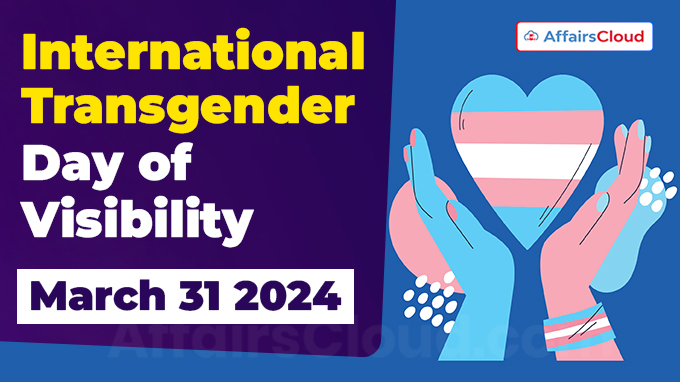 International Transgender Day of Visibility (TDOV) is annually observed across the globe on 31 March to celebrate transgender, nonbinary, and gender expansive/gender non-conforming individuals and the contributions of trans people and the nonbinary community.
International Transgender Day of Visibility (TDOV) is annually observed across the globe on 31 March to celebrate transgender, nonbinary, and gender expansive/gender non-conforming individuals and the contributions of trans people and the nonbinary community.
- This Day also recognises and raises awareness of the discrimination faced by transgender people worldwide.
- The Day aims to draw attention toward eliminating poverty, violence, and discrimination based on gender identity faced by the community.
Transgender Flag:
i.The Transgender Pride Flag was created by American trans woman Monica Helms in 1999.
ii.The flag represents the transgender community and consists of 5 horizontal stripes: 2 light blue(Represents boys), 2 pink(Represents girls), and 1 white(Represents those who are transitioning) in the center.
Background:
i.The Day was created by Rachel Crandall Crocker, an American transgender advocate, a licensed psychotherapist, and the Executive Director and co-founder of Transgender Michigan, in 2009.
ii.The 1st ever International Transgender Day of Visibility was observed on 31 March 2009.
Note: Rachel Crandall Crocker also runs the Transgender Michigan helpline, the first transgender helpline in the USA.
Transgender:
i.The word “transgender” shortly “trans” – is an umbrella term for people whose gender identity is different from the sex assigned to the person at birth.
- Gender identity: It refers to a person’s internal sense of being male, female, or something else; different from the sex assigned at birth.
- Gender expression: It refers to the way a person communicates gender identity to others through behaviour, clothing, hairstyles, voice, or body characteristics.
ii.Challenges faced by trans people includes, Lack of legal protection; Poverty; Stigma, Harassment and Discrimination; Violence Against Trans People; Lack of Healthcare Coverage; and Lack of accurate Identity Documents.
Efforts of the Indian Government to Support Trandgeders:
i.The Transgender Persons (Protection of Rights) Bill, 2016 was introduced in the Lok Sabha in 2016.
- The bill defines a transgender person and prohibits discrimination against them in areas such as education, employment, and healthcare, among others.
ii.The Transgender Persons (Protection of Rights) Act 2019 seeks to mitigate the stigma, discrimination, and abuse against the marginalised transgender section and bring them into the mainstream of society.
iii.The Transgender Persons (Protection of Rights) Rules, 2020 were formulated and published in the Gazette of India on September 29, 2020.
iv.The Ministry of Social Justice and Empowerment (MoSJE) introduced the Support for Marginalised Individuals for Livelihood and Enterprise (SMILE) scheme on February 12, 2022.
- This initiative aims to address the needs of marginalised individuals, including the transgender community and those engaged in begging, by providing comprehensive support measures.
Related Observance:
Transgender Day of Remembrance (TDOR): It is an annual observance on 20 November that honors the memory of the transgender people whose lives were lost in acts of anti-transgender violence.
- TDOR was inspired by the brutal death of Rita Hester, a black transgender woman in Boston, Massachusetts, who was brutally killed in her apartment in 1998.




